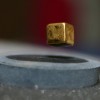Diamagnetic Levitation Experiment with Cube Magnets
Diamagnetic materials hold properties that repel an applied magnetic field. Because of these properties, it is possible to levitate a magnet when used in conjunction with diamagnetic materials.
The principle of diamagnetic levitation has been known since the 1930s but has only recently been used in practical applications like transport systems. A diamagnetic levitation experiment like the one below is both fun and educational.
Supplies
- 2 carbon-graphite plates
- Cube magnets, such as 1/8'' x 1/8'' x 1/8''
- Lifting magnet, such as 1/2'' x 1/8'' x 1/8''ring magnets
- Stand (wood, glue, threaded rod)
The experiment stand allows for the slight adjustments needed to achieve magnetic levitation. You can make a stand out of wood or another non-magnetic material. For instructions on how you can make your own stand, follow this link.
Steps
- Place the cube magnet on the bottom carbon-graphite plate.
- Slowly lower the lifting magnet closer to the cube magnet and plate. If you lower the lifting magnet too far, it will cause the magnet to lift towards it. However, at the right distance, you will be able to see the cube magnet start to levitate.
- Place the other plate on top of the magnet using the stand. You can make any slight adjustment so that the cube magnet is levitating between the plate at an equal distance.
- Now that you have achieved magnetic levitation, you can experiment some more by blowing on the magnet.
- Observe the magnet’s reaction. It should spin and remain levitating in place.
- What would happen to the levitating magnet if the temperature decreases?
- What is the purpose of the lifting magnet?
- Is magnetic levitation used in real-time applications and if so, how?

